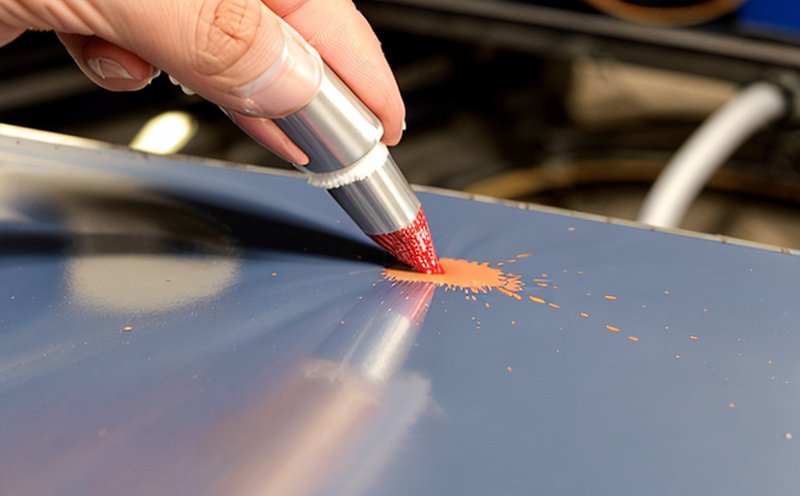ISO 6504 Paints and Varnishes Determination of Hiding Power of Furniture Coatings
The determination of hiding power is a critical aspect in the quality control and development of furniture coatings. This test, outlined by ISO 6504, measures how well a paint or varnish covers a surface. The hiding power, which is an indicator of opacity, plays a significant role in the aesthetic appeal and durability of coated furniture pieces.
The process involves applying a series of known thicknesses of coating to a substrate, followed by visual assessment using standardized viewing conditions. This test helps manufacturers ensure their products meet industry standards, thereby enhancing consumer satisfaction and product longevity.
For quality managers and compliance officers dealing with furniture coatings, this test ensures that the final product meets both aesthetic and functional expectations. R&D engineers can rely on it to refine formulations for better performance, while procurement teams benefit from verifying suppliers' adherence to specifications.
The testing procedure involves several steps, including:
- Preparation of the substrate material.
- Application of coating at various thicknesses.
- Drying and curing as per manufacturer's recommendations.
- Visual inspection under controlled lighting conditions.
The results provide a numerical value representing the hiding power, which is essential for product development and quality assurance. This data aids in making informed decisions about raw materials, production processes, and final product specifications.
To further illustrate the importance of this test, consider its real-world application in the furniture industry:
- Customer Satisfaction: Higher hiding power means less visible imperfections on finished products, leading to happier customers.
- Durability: Properly measured hiding power ensures that coatings can withstand environmental factors without showing signs of wear prematurely.
- Compliance: Adhering to ISO standards helps businesses avoid legal issues and maintain a reputable image in the market.
The following table outlines typical steps involved in preparing for this test:
| Step | Description |
|---|---|
| Substrate Preparation | Clean and dry the substrate material to ensure accurate measurements. |
| Coating Application | Apply coating in layers of increasing thickness. |
| Drying/Curing | Follow manufacturer's guidelines for drying or curing time. |
| Visual Inspection | Evaluate the sample under controlled lighting conditions. |
The next table provides a summary of the test results and their implications:
| Hiding Power Value | Implications for Product Quality |
|---|---|
| < 50% Hiding | Poor coverage, visible imperfections. |
| 50-70% Hiding | Adequate but not ideal coverage. |
| > 70% Hiding | Sufficient opacity, high-quality finish. |
In conclusion, the ISO 6504 test is an essential tool in ensuring that furniture coatings meet both aesthetic and functional standards. By measuring hiding power accurately, manufacturers can enhance product quality and customer satisfaction while maintaining compliance with international standards.
Scope and Methodology
The scope of the ISO 6504 test includes the determination of hiding power for paints and varnishes used in furniture coatings. This involves measuring how effectively these materials cover a surface, which is crucial for ensuring both aesthetic appeal and durability.
| Scope | Description |
|---|---|
| Paints and Varnishes | This includes all types of paints and varnishes used in furniture manufacturing. |
| Surface Preparation | The substrate must be clean, dry, and free from contaminants to ensure accurate measurements. |
| Coating Application | Coatings are applied at different thicknesses following standardized procedures. |
| Visual Inspection | Samples are evaluated under controlled lighting conditions for hiding power assessment. |
The methodology for this test is detailed and follows the guidelines set forth in ISO 6504. It involves several key steps:
- Preparation of Substrate: Clean and dry the substrate to ensure accurate measurements.
- Coating Application: Apply coatings at increasing thicknesses, following specific instructions from manufacturers.
- Drying/Curing: Allow the coated samples to dry or cure according to manufacturer's recommendations.
- Visual Inspection: Evaluate the samples under controlled lighting conditions to determine hiding power.
The results of this test are presented as a numerical value representing the hiding power, which is essential for product development and quality assurance. This data helps in making informed decisions about raw materials, production processes, and final product specifications.
Benefits
The benefits of conducting ISO 6504 tests are numerous and significant for the furniture industry:
- Aesthetic Appeal: Higher hiding power ensures that coatings look smooth and consistent, enhancing the overall appearance of furniture.
- Durability: Properly measured hiding power helps ensure that coatings can withstand environmental factors without showing signs of wear prematurely.
- Compliance: Adhering to ISO standards ensures that products meet regulatory requirements, avoiding potential legal issues and maintaining a reputable image in the market.
- Informed Decision Making: Accurate test results provide valuable information for R&D teams to improve product formulations.
- Customer Satisfaction: Products with higher hiding power are more likely to meet or exceed customer expectations, leading to greater satisfaction.
- Competitive Advantage: Consistently high-quality products can set a company apart from competitors in the market.
In summary, ISO 6504 tests offer numerous benefits that contribute to the overall success and reputation of furniture manufacturing companies.
Quality and Reliability Assurance
To ensure the reliability and accuracy of our testing, we employ rigorous quality control measures:
- Standardized Procedures: Adherence to ISO 6504 ensures consistent and accurate results.
- Calibrated Equipment: All instruments used are regularly calibrated to industry standards.
- Trained Personnel: Our staff undergo continuous training to maintain expertise in the latest testing techniques.
- Continuous Monitoring: Regular audits and reviews of test results ensure ongoing compliance with international standards.
We also provide detailed reports that include all relevant data, ensuring transparency and traceability throughout the testing process. This comprehensive approach guarantees high-quality, reliable results that meet industry expectations.





